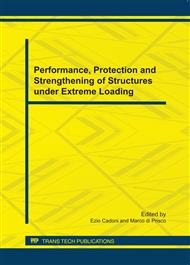p.15
p.26
p.39
p.45
p.51
p.57
p.63
p.69
p.75
How to Determine the Dynamic Fracture Energy of Concrete. Theoretical Considerations and Experimental Evidence
Abstract:
Data on the dynamic fracture energy of concrete are scarce and also not consistent due to different test methods, data analyses and definitions. In [1] the authors summarized and evaluated the test methods. Suggestions for the standardization of dynamic tensile testing were given. In the current paper the discussion is continued. First, definitions for the fracture energy and the relevant parameters are given. Next, theoretical considerations are given for the different rate dependency regimes of the dynamic tensile strength. Fracture and damage mechanics form the basis for the theoretical modeling. Based on the same principles, it is shown that the enhancement of the fracture energy occurs at higher loading rates than for the tensile strength. Phenomenological models to quantify the dynamic fracture energy are still lacking. To quantify the dynamic fracture energy, uniaxial test conditions are required. The Hopkinson bar technique meets this requirement. The paper presents and evaluates available data and relates these to the theoretical considerations.
Info:
Periodical:
Pages:
51-56
Citation:
Online since:
July 2011
Authors:
Keywords:
Price:
Сopyright:
© 2011 Trans Tech Publications Ltd. All Rights Reserved
Share:
Citation:


